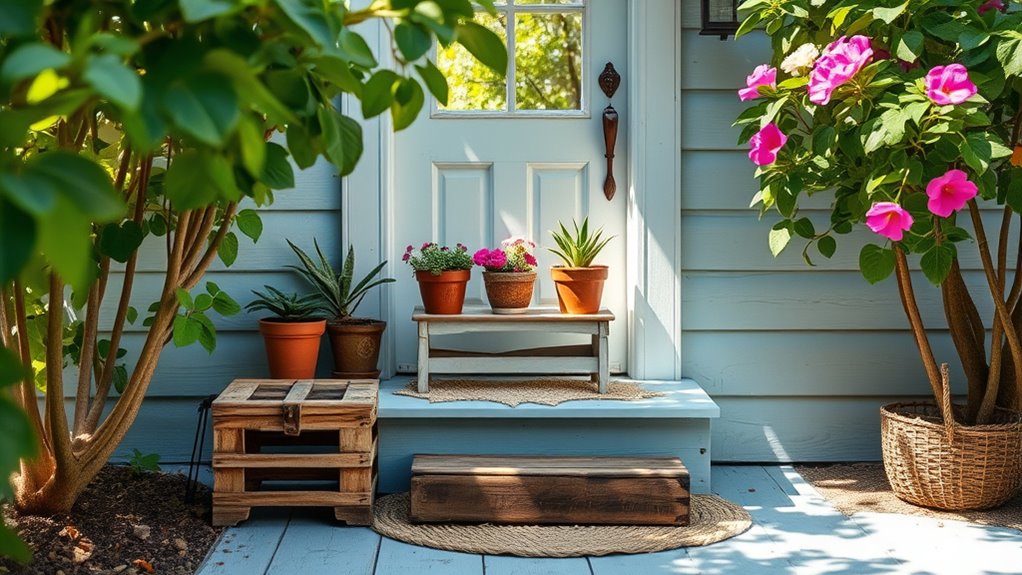To build DIY tiny porch and entrance steps, start by choosing durable materials like concrete or weather-treated wood. guarantee each step has a consistent height (around 7 inches) and depth (at least 10 inches) for safety and comfort. Secure the steps firmly to the ground and add textured surfaces for slip resistance. Incorporate handrails if you have more than two steps. For detailed tips, safety advice, and material options, keep exploring how to create a sturdy, attractive entrance.
Key Takeaways
- Select durable materials like concrete, treated wood, or composite for a stable, weather-resistant foundation.
- Ensure consistent step dimensions: approximately 7-inch rise and 10-inch tread depth for safety.
- Incorporate slip-resistant surfaces or treatments to prevent accidents, especially in wet conditions.
- Follow local building codes regarding width, height, and safety features, including handrails if needed.
- Regularly inspect and maintain steps, securing fasteners and reapplying non-slip treatments for longevity.

Creating a DIY tiny porch and entrance steps is a practical way to enhance your home’s curb appeal without breaking the bank. When you start planning, one of the most important steps is selecting the right materials. Your material selection impacts both the durability and the look of your steps, so choose wisely. For a sturdy foundation, concrete blocks or pressure-treated wood work well. Concrete is long-lasting and requires minimal maintenance, while wood can provide a warmer, more inviting aesthetic. If you opt for wood, make sure it’s treated to withstand the elements, especially if you live in a rainy or snowy climate. For the treads and risers, composite materials or cedar are good options—they resist rot and warping better than untreated wood. Additionally, consider the weight capacity of the materials, especially if you’ll add decorative elements or plan to sit on the steps.
Safety considerations should be at the forefront of your project. You want your steps to be stable and non-slip, so think about how to prevent accidents. When choosing materials, look for options with textured or slip-resistant surfaces. If you’re using wood, applying a non-slip paint or textured tape on the treads can help prevent slipping, especially in wet weather. The dimensions of your steps are equally important; ensure they are uniform, with a comfortable rise (height) and run (depth). A typical step height is about 7 inches, and the tread should be at least 10 inches deep to provide enough space for safe footing. You should also plan for handrails or grab bars if your steps are more than two or three, especially for elderly or mobility-challenged visitors. Securing the steps firmly to the ground and anchoring them properly is critical to prevent shifting or wobbling over time.
Furthermore, it’s wise to double-check local building codes and regulations before starting your project. Some areas might have specific requirements for stairs and porch construction, such as minimum width or height restrictions, which you need to follow for safety and legal reasons. Using quality fasteners and connectors will strengthen your structure and reduce the risk of failure. Regular inspection and maintenance are also key—tighten loose screws, replace worn wood, and keep the surface clean and free of debris. Incorporating a knowledgeable understanding of historic preservation can also help you choose materials and designs that complement your home’s aesthetic and ensure longevity. By carefully selecting your materials and prioritizing safety considerations, you’ll build a tiny porch and entrance steps that are not only attractive but also secure and long-lasting, making your home more welcoming with every step you take.
Frequently Asked Questions
What Tools Are Essential for Building Tiny Porch Steps?
You’ll need essential tools like a saw, drill, measuring tape, level, and screwdriver to build tiny porch steps. These tools help you cut, assemble, and guarantee everything is level and secure. While working on your project, consider adding garden decor around your porch and installing lighting options to create a welcoming atmosphere. Having the right tools makes the process smoother, and the finishing touches add charm and practicality to your entrance.
How Do I Choose Durable Materials for Outdoor Steps?
When choosing materials for outdoor steps, you’re lucky because stone durability makes it a top choice for longevity and weather resistance. Pair this with properly treated wood—using sealants and preservatives—to guarantee it withstands moisture and pests. You might find that combining stone for the base and treated wood for the treads offers the perfect balance of durability and aesthetic appeal, keeping your porch looking great for years to come.
Can I Customize the Height and Width of the Steps?
Yes, you can customize the height and width of your steps. Use measurement techniques like a tape measure and level to guarantee accurate dimensions. Consider your specific needs and space constraints when planning your customization options. Adjust the rise and run to match your comfort and safety preferences, making sure the steps fit seamlessly with your porch’s design. Proper measurements ensure your customized steps are both functional and visually appealing.
How Weather-Resistant Are DIY Porch Step Materials?
Weather-resistance varies widely depending on your materials and maintenance. You can make your DIY porch steps remarkably resilient by applying weatherproof coatings, which shield against snow, sleet, and rain. Durable materials like treated wood, composite, or concrete tend to boast better longevity. Regular sealing, staining, and inspecting help prolong the lifespan, ensuring your steps stay sturdy and safe through seasonal storms and sun.
What Safety Features Should I Include in the Design?
You should include a sturdy handrail installation to prevent falls and enhance safety. Make sure to use slip-resistant surfaces on all steps to reduce the risk of slipping, especially in wet conditions. Additionally, consider adding lighting for visibility at night and ensuring the steps are securely anchored. These features create a safer entryway, giving you peace of mind with every step you take.
Conclusion
Building your own tiny porch and entrance steps is a rewarding project that boosts your home’s curb appeal and functionality. With simple materials and clear instructions, you can create a welcoming entryway that reflects your style. Are you ready to transform your entrance and enjoy the satisfaction of a DIY accomplishment? Remember, every step you take brings you closer to a more inviting and personalized home. Why not start today and make your vision a reality?







